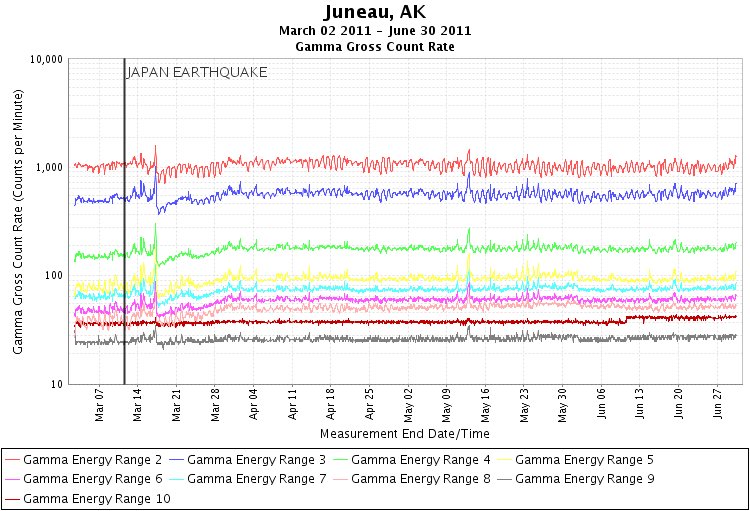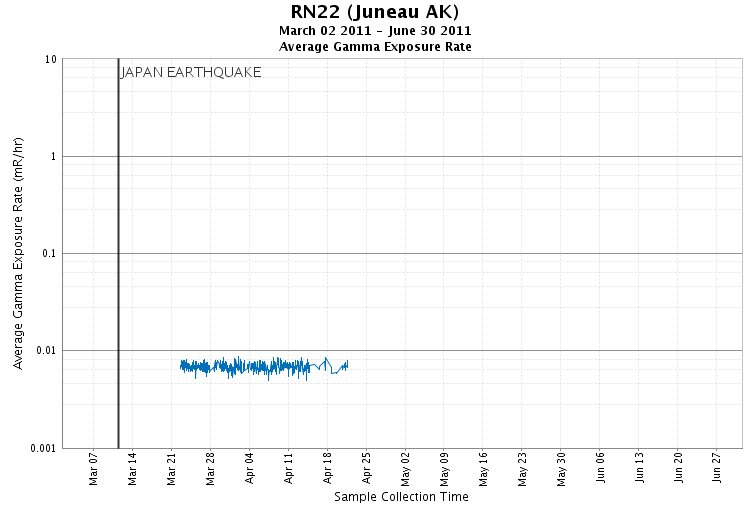Japanese Nuclear Emergency: Radiation Monitoring
RadNet Data for Juneau, Alaska
This page shows multiple types of data from this location, including readings from our near-real-time air monitor and data from the detailed laboratory sample analysis.
Three types of results from the RadNet stationary and deployable near-real-time air monitors at this location are presented below: gamma gross count rate and beta gross count rate from the stationary monitor and average gamma exposure rate from the deployable monitor.
On this page:
- Gross Gamma Air Monitoring Data
- Gross Beta Air Monitoring Data
- Gamma Exposure Rate Air Monitoring Data
- Laboratory Data
Gross Gamma Air Monitoring Data
To-date, levels recorded at this monitor have been thousands of times below any conservative level of concern.

The gamma data measures radiation from all radionuclides that emit gamma rays and splits them into ranges of energy. The word gross, or total, indicates that the measurement is from all gamma emitting radionuclides. Not all gamma rays have the same amount of energy. Breaking the data into discrete energy ranges helps scientists to determine which radionuclides may be present. (Learn more about gamma radiation.)
Notes on the Data
- Brief gaps in RadNet data represent instrument error.
- Larger gaps (>1 day) occasionally appear when RadNet monitors are taken offline for servicing.
- A notice is posted when monitors are off-line for servicing. A blank graph indicates that one part of a meter on the monitor is not working.
- Electrical interference can cause spikes, shown on graphs as one point significantly higher than the rest of the data.
- As you view data, be aware that there are often large differences in normal background radiation among the monitoring locations because background radiation levels depend on altitude and the amount of naturally occurring radioactive elements in the local soil. What is natural in one location is different from what is natural in another.
- To get the data shown in this graph, please search using our query tool.
- More information about air monitoring data.
Gross Beta Air Monitoring Data
To-date, levels recorded at this monitor have been thousands of times below any conservative level of concern.

The beta gross count rate measures the radiation from all radionuclides that emit beta particles, which is indicated by the term gross or total. The term count rate tells us how quickly beta particles are being detected, which indicates how much radioactivity the monitor is seeing. (Learn more about beta radiation.)
Notes on the Data
- Brief gaps in RadNet data represent instrument error.
- Larger gaps (>1 day) occasionally appear when RadNet monitors are taken offline for servicing.
- A notice is posted when monitors are off-line for servicing. A blank graph indicates that one part of a meter on the monitor is not working.
- Electrical interference can cause spikes, shown on graphs as one point significantly higher than the rest of the data.
- As you view data, be aware that there are often large differences in normal background radiation among the monitoring locations because background radiation levels depend on altitude and the amount of naturally occurring radioactive elements in the local soil. What is natural in one location is different from what is natural in another.
- To get the data shown in this graph, please search using our query tool.
- More information about air monitoring data.
Gamma Exposure Rate Air Monitoring Data

The graph shows the external exposure rate data, which is the dose, or amount of radiation, you would receive on the outside of your body if you were standing in that particular location. Background, or normal, radiation levels depend on factors including altitude and the amount of naturally occurring radioactive elements in the soil. Background external exposure rates typically range between 0.005 and 0.020 millirem per hour (mR/hr) - levels that are thousands of times below any conservative level of concern.
Notes on the Data
- Brief gaps in RadNet data represent instrument error.
- Larger gaps (>1 day) occasionally appear when RadNet monitors are taken offline for servicing.
- A notice is posted when monitors are off-line for servicing. A blank graph indicates that one part of a meter on the monitor is not working.
- Electrical interference can cause spikes, shown on graphs as one point significantly higher than the rest of the data.
- As you view data, be aware that there are often large differences in normal background radiation among the monitoring locations because background radiation levels depend on altitude and the amount of naturally occurring radioactive elements in the local soil. What is natural in one location is different from what is natural in another.
- To get the data shown in this graph, please search using our query tool.
- More information about air monitoring data.
Laboratory Data from Air Filter and Air Cartridge Analysis
During detailed filter analyses from several RadNet air monitor locations across the nation, the U.S. Environmental Protection Agency (EPA) identified trace amounts of radioactive isotopes consistent with the Japanese nuclear incident. These types of findings are to be expected in the coming days and are far below levels of public health concern.
